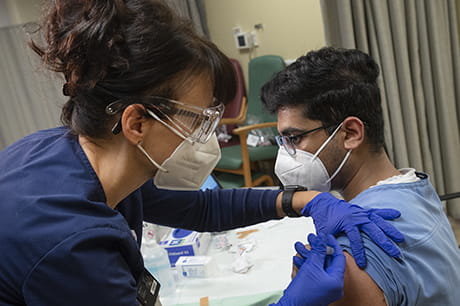What’s mRNA and how is it used in COVID vaccines?
Thinking about getting a COVID vaccine? Here’s what you need to know.
The COVID-19 vaccines that have been given Emergency Use Authorization (EUA) by the FDA use something called mRNA to cause an immune response to COVID-19. This is different from most vaccines you’re probably familiar with — like the flu vaccine, which uses a protein from the virus itself.
But unless you’re a geneticist or an immunologist, you might need more of an explanation. Let’s break it all down.
The ‘m’ stands for messenger
“The ‘m’ in mRNA stands for ‘messenger,’” explains Juliann Savatt, a genetic counselor at Geisinger. “Messenger RNA is a normal part of our bodies. Our genetic material, our DNA, is like an instruction manual that tells our body how to make proteins. Every time our DNA codes for proteins — whether it’s telling our body how to make our heart, skin or brain — mRNA is part of the process. Our mRNA is actually the middle step that helps take the instructions in your DNA so that they can be used to make those proteins.”
The mRNA in the COVID vaccines gives instructions for your cells to make a harmless piece of protein called a “spike protein” that is found on the surface of the COVID virus. Your body recognizes this as a potential threat and creates antibodies against it. Then, if you’re exposed to the real virus, these antibodies make it easier for your body to fight it off.
“All of this is happening separate from where our genetic material is kept in our cells,” Ms. Savatt explains. “The mRNA never enters the nucleus of the cells where your DNA is stored and does not alter your DNA code. Once the cell is finished using its instructions, the mRNA is broken down and eliminated from your body. While the mRNA vaccine is new, using mRNA in our bodies is something that happens all the time — it’s a normal part of how the body works.”
mRNA vaccines have been studied for decades
“What makes mRNA vaccines such a breakthrough is that they can be created entirely in a lab using materials that are readily available,” says Ms. Savatt. “All we needed to do was sequence the genetic material of the virus — and with COVID, that happened quickly.”
Because everything happens right in a lab, the process can be standardized and scaled up, so vaccine development against COVID happened faster than with traditional methods.
The mRNA approach has been studied for vaccines to protect against flu, Zika, rabies and cytomegalovirus (CMV). Cancer research has also used mRNA to trigger the immune system to target specific cancer cells.
What is an Emergency Use Authorization?
For an EUA to be issued for a vaccine, the FDA must determine that the known and potential benefits of the vaccine outweigh the known and potential risks — and there must be enough manufacturing information to ensure its quality and consistency.
An EUA submission includes all the safety data that was accumulated through phase 1 and 2 studies. It’s also expected that at least half the vaccine recipients in the phase 3 clinical trials (the final phase) have had a 2-month follow-up after their last shot. An EUA request must also include a phase 3 safety database of well over 3,000 vaccine recipients, representing a high proportion of participants enrolled, who have been followed for serious adverse events for at least a month after completing the full vaccination regimen.
“The COVID-19 pandemic has sickened too many people and taken too many lives,” says Ms. Savatt. “These vaccines are game-changers and are going to help get us back to life as normal — and not a minute too soon.”
Next steps:
Learn more about COVID-19 vaccine safety
Travel safety tips during a pandemic
COVID-19: Keeping everyone safe at home

